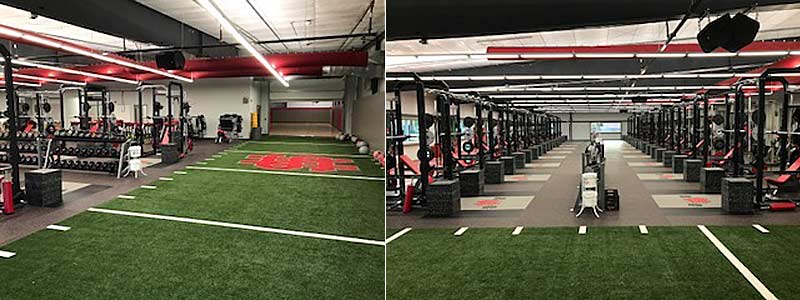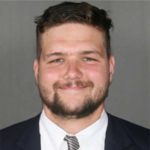
Last month, we raved about Guyer High School in Denton, Texas, and how high schools in Texas have taken strength and conditioning to new heights with the pinnacle of facilities. This month, we move on to North Scott High School in Eldridge, Iowa, which is led by veteran head strength and conditioning coach Tony Stewart.
Coach Stewart has been at North Scott for 13 years and played a crucial part in developing the new Lancer Athletic Building (LAB) in the spring of 2017. This space was a blank slate that Coach Stewart, along with Tim O’Neill at Power Lift, designed for exactly how he liked to coach and run training.
Video 1. The redesigned weight room at North Scott High School.
Video 2. Coach Tony Stewart provides a virtual tour of the facility.
Usage of Space in the Design
I asked Coach Stewart what some of the biggest keys were going into the building and design of this space:
“Sight lines were number one. When there are a lot of kids in the room and not a lot of coaches, it’s important to be able to see everyone in the room. We went with full racks instead of half racks because high school kids need the boundary. We have a great storage closet as well as storage on the racks and at the end of DB racks also.
We like having the DBs between racks to limit movement around the room. We would really like our kids to be within the same area for the entirety of their training session, if at all possible. The organization of the DBs near the racks really helps that flow. The equipment from Power Lift and plates from Uesaka really are the focus on the decorations around the room.”
Sight lines were the #1 (priority when designing the space). When there are a lot of kids in the room and not a lot of coaches, it’s important to be able to see everyone in the room. Share on XI never even thought about why coaches pick a type of racks, other than space-saving with half-racks or the look of full racks, before hearing Coach Stewart explain the idea that the full rack is essentially a corral for his athletes, who, at the high school level, tend to drift around.
The “flow” of the room is something that a lot of coaches want to improve in their own older facilities, and here Coach Stewart mentioned the idea of having the DB spaces between the racks to again keep the kids in their areas and not running around other athletes who are training, which can cause dangerous situations.

I asked Coach Stewart, after he had the space set, why they chose the equipment company they did:
“Relationships, to start—the people at Power Lift are top-notch. The equipment itself is the best on the market as far as longevity and durability. Power Lift equipment has the strongest gauge steel you can find in the industry, and with the amount of use and abuse our equipment takes, that durability is important. Power Lift will also customize anything you want. They have a great team.”
We want to feel like the company that takes that money will treat us like they would the mega D1 school that spends $1 million on equipment. Share on XI think something a lot of companies forget is how coaches like to feel during this process. We know we are about to drop a lot of money (which can be relative based on the project), but we want to feel like the company that takes that money will treat us like they would the mega D1 school that spends $1 million on equipment. That to me is the difference between good companies and great ones!

Specialty Equipment
Aside from the normal racks, bars, DBs, and plates, coaches all over the country are trying to find new, creative ways to train their athletes when they are injured, taller/shorter, or have more experience. This is where the need for specialty equipment comes into play, and North Scott has some of the best:
“We have two pit sharks, one leg press, and two kBoxes that we used for alternative and specialized training for certain individuals. We have a variety of training and specialty bars as well and a turf area.”

The nice thing about specialty equipment is the ability to use it to progress/regress athletes based on their needs as well as provide injured athletes with the ability to continue to train during the rehab process. Something else that a lot of coaches overlook is open space and/or turf; in my opinion, this counts as “specialty” because it allows for infinite opportunities to utilize that space, from warm-ups to a training station for the session.
“We typically use our specialty pieces for injured kids or if we need to modify for any other reason. In our program, we also change exercises instead of rep ranges early on to elicit a new/different adaptation. For example, we will front squat, back squat, safety bar squat, DB bench, BB bench, Swiss bar bench. The different pieces of equipment help to make things new and fresh, even though we are fairly simple in our programming.”
Personally, I have athletes who—without something like a safety bar—would not be able to do anything but maybe isolated machines for the lower body (which is a great option, but over a four-year period, it isn’t enough). This rationale led to the purchase of these pieces of equipment that other athletes can use as well.

Tips for Coaches
Coach Stewart finishes our talk about the tips he has for coaches in this process:
“Don’t get what looks good or what you think would be good to have. Put thought into how you program, what you will actually use, and how easily the equipment adjusts in a short amount of time. I can have all the bells and whistles and attachments I want, but if 14- to 18-year-old kids can’t quickly change it out or would never really need it, then don’t get it. Keep it simple and usable and always consider storage for any attachments.”
Put thought into how you program, what you will actually use, and how easily the equipment adjusts in a short amount of time. Share on XSomething coaches don’t think about while designing these spaces is this is your chance to have everything match the way you coach and who you coach. Like Coach Stewart mentions for his space, there must be the thought of who you are training when buying equipment. For example, you wouldn’t want to buy a lot of 100-pound plates for a high school facility because the number of kids who could actually use them would be very limited. Instead, spend that money on squat wedges or safety bars because those are pieces that everybody can use.
Since you’re here…
…we have a small favor to ask. More people are reading SimpliFaster than ever, and each week we bring you compelling content from coaches, sport scientists, and physiotherapists who are devoted to building better athletes. Please take a moment to share the articles on social media, engage the authors with questions and comments below, and link to articles when appropriate if you have a blog or participate on forums of related topics. — SF

